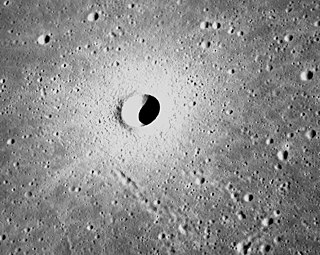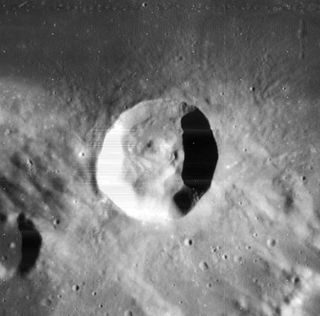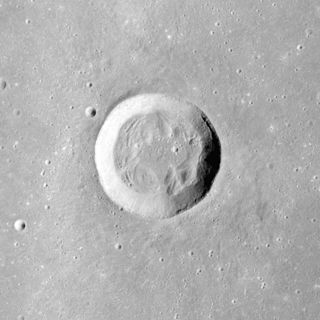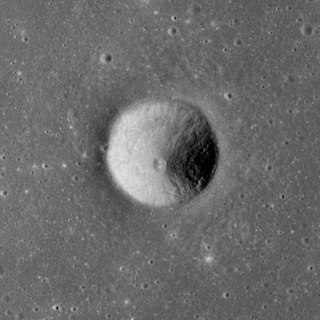
Linné is a small lunar impact crater located in the western Mare Serenitatis. It was named after Swedish botanist Carl von Linné. The mare around this feature is virtually devoid of other features of interest. The nearest named crater is Banting to the east-southeast. The estimated age of this copernican crater is only a few tens of millions of years. It was earlier believed to have a bowl shape, but data from the LRO showed that it has a shape of a flattened, inverted cone. The crater is surrounded by a blanket of ejecta formed during the original impact. This ejecta has a relatively high albedo, making the feature appear bright.

Menelaus is a young lunar impact crater located on the southern shore of Mare Serenitatis near the eastern end of the Montes Hæmus mountain range. Its diameter is 27 km. To the southwest is the small crater Auwers, and to the west-southwest is the even smaller Daubrée. To the northeast is a faint rille system named the Rimae Menelaus.

Posidonius is a lunar impact crater that is located on the north-eastern edge of Mare Serenitatis, to the south of Lacus Somniorum. It was named after ancient Greek philosopher and geographer Posidonius of Apamea. The crater Chacornac is attached to the southeast rim, and to the north is Daniell.

Ångström is a small lunar impact crater located on the border between Oceanus Procellarum to the west and Mare Imbrium to the east. To the south is a formation of mountains rising out of the mare named the Montes Harbinger. To the east are some wrinkle ridges named the Dorsum Bucher and Dorsa Argand. This crater is bowl-shaped, with a circular rim and inner walls that slope down to the small central floor. It has a higher albedo than the surrounding maria.

Banting is a small, bowl-shaped lunar impact crater located near the middle of the Mare Serenitatis on the Earth's moon.

Carlini is a small lunar impact crater located in the Mare Imbrium. It was named after Italian astronomer Francesco Carlini. The crater is bowl-shaped with a small central floor. It has a higher albedo than the surrounding mare, making it prominent due to its isolated location. To the south is a wrinkle ridge named Dorsum Zirkel, and farther south lies the peak Mons La Hire.

Luther is a small lunar impact crater on the northwest part of Mare Serenitatis, at the inlet to Lacus Somniorum. To the east-southeast is the large crater Posidonius. Luther has a circular rim and is cup-shaped, with no appreciable wear from impact erosion. It lies across a wrinkle ridge on the lunar mare.

Bobillier is a tiny, cup-shaped lunar impact crater in the southwest part of Mare Serenitatis. It was named after French geometer Étienne Bobillier in 1976. It lies to the north-northwest of the crater Bessel. To the south and west is a wrinkle ridge designated Dorsum Buckland. Bobillier was previously identified as Bessel E.

Very is a small lunar impact crater located in the eastern part of Mare Serenitatis, to the west-southwest of Le Monnier. It lies upon a wrinkle ridge that runs to the north and south named Dorsa Smirnov. It was named after American astronomer Frank W. Very. The crater was previously known as Le Monnier B, a satellite crater of Le Monnier, before being renamed by the IAU in 1973.

Al-Bakri is a small lunar impact crater on the northwest edge of Mare Tranquillitatis. It is named after the Spanish Arab geographer and historian Abu Abdullah al-Bakri. It is just south of the eastern arm of the Montes Haemus that borders the Mare Serenitatis to the north. To the east-northeast is the prominent crater Plinius. South of the crater are the rilles of the Rimae Maclear.

C. Herschel is a small lunar impact crater that lies on the western part of Mare Imbrium. It is named after British astronomer Caroline Herschel. It is a circular, bowl-shaped formation that has not undergone significant erosion. The interior floor has the same low albedo as the surrounding lunar mare. To the south-southwest is the similar crater Heis. C. Herschel lies on a wrinkle ridge of the lunar mare named the Dorsum Heim.

Clerke is a tiny lunar impact crater named after Irish astronomer Agnes Mary Clerke, who played a role in bringing astronomy and astrophysics to the public in Victorian England. It is located near the eastern edge of Mare Serenitatis in the midst of a rille system named the Rimae Littrow after the crater Littrow to the east. It is roughly circular and cup-shaped, with a relatively high albedo. In a valley to the southeast is the landing site of the Apollo 17 mission. Clerke was previously designated Littrow B.

Bessel is a small lunar impact crater that is located in the southern half of the Mare Serenitatis. The crater was named after the German astronomer Friedrich Wilhelm Bessel in 1935. Despite its small size, this is the largest crater to lie entirely within the mare. It lies to the north-northeast of the crater Menelaus.

Sulpicius Gallus is a small, bowl-shaped lunar impact crater that lies near the southwestern edge of the Mare Serenitatis. The crater is named after the 2nd century BC Roman astronomer Gaius Sulpicius Gallus.

Sarabhai is a small, circular, bowl-shaped crater on the Mare Serenitatis, in the northeast quadrant of the Moon. The formation is relatively isolated, being located to the northeast of the crater Bessel. It lies along a wrinkle ridge designated the Dorsum Azara.

Fontenelle is a lunar impact crater that is located along the northern edge of Mare Frigoris, in the northern part of the Moon. To the northeast is the remnant of the crater Birmingham. Due to its location, this crater appears oval in shape when observed from the Earth because of foreshortening.

Fabbroni is a small lunar impact crater that lies along the northern edge of the Mare Tranquillitatis, at the eastern edge of the gap where the lunar mare joins Mare Serenitatis to the north. To the southeast is the crater Vitruvius.

Hornsby is a tiny lunar impact crater in the western part of the Mare Serenitatis, a lunar mare in the northeast quadrant of the Moon's near side. It was named after British astronomer Thomas Hornsby. It is a solitary formation that is located at least 100 kilometers from any significant craters, although the curiously shaped depression Aratus CA lies about 50 km to the west-northwest. To the north-northwest is Linné, a feature notable for its skirt of high-albedo material. To the west of Hornsby is the wrinkle ridge Dorsum Von Cotta.
Dorsum Von Cotta is a wrinkle ridge at 23.2°N 11.9°E in Mare Serenitatis on the Moon. It is 183 km long and trends south to north at approximately the lunar 12th parallel. It was named after German geologist Bernhard von Cotta in 1976.






















